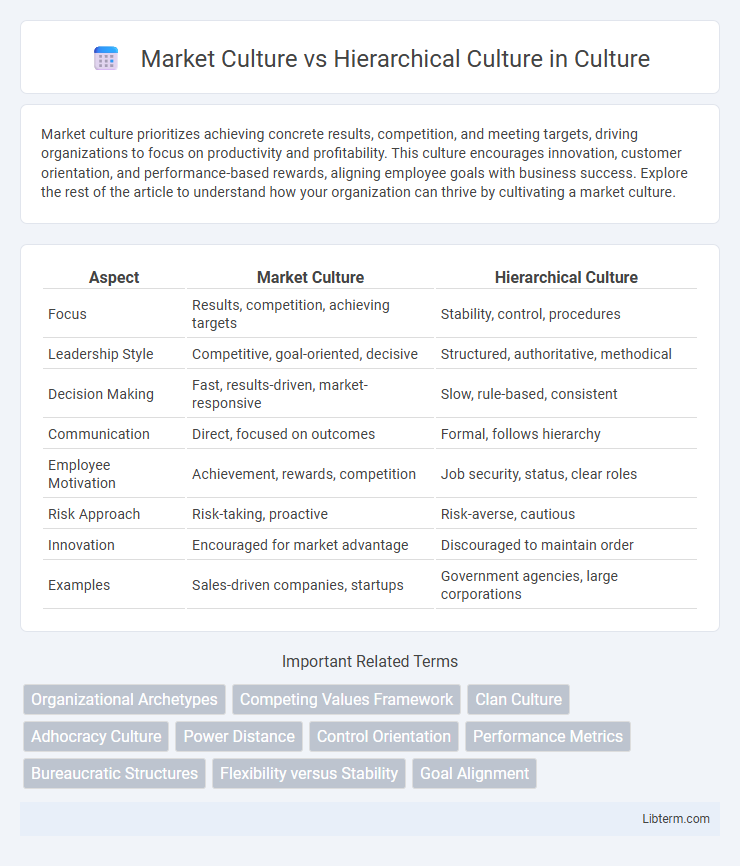Market culture prioritizes achieving concrete results, competition, and meeting targets, driving organizations to focus on productivity and profitability. This culture encourages innovation, customer orientation, and performance-based rewards, aligning employee goals with business success. Explore the rest of the article to understand how your organization can thrive by cultivating a market culture.
Table of Comparison
| Aspect | Market Culture | Hierarchical Culture |
|---|---|---|
| Focus | Results, competition, achieving targets | Stability, control, procedures |
| Leadership Style | Competitive, goal-oriented, decisive | Structured, authoritative, methodical |
| Decision Making | Fast, results-driven, market-responsive | Slow, rule-based, consistent |
| Communication | Direct, focused on outcomes | Formal, follows hierarchy |
| Employee Motivation | Achievement, rewards, competition | Job security, status, clear roles |
| Risk Approach | Risk-taking, proactive | Risk-averse, cautious |
| Innovation | Encouraged for market advantage | Discouraged to maintain order |
| Examples | Sales-driven companies, startups | Government agencies, large corporations |
Understanding Market Culture: Key Characteristics
Market Culture emphasizes competitiveness, goal achievement, and profitability, driving organizations to focus on external positioning and results-oriented strategies. Key characteristics include a strong emphasis on customer orientation, market share growth, and efficient resource utilization to outperform competitors. This culture values performance metrics, aggressive negotiation tactics, and strategic decision-making aligned with overall business objectives.
Defining Hierarchical Culture: Main Features
Hierarchical culture emphasizes structure, control, and clear authority lines, prioritizing stability and efficiency within organizations. It features formal rules, standardized procedures, and well-defined roles that enhance predictability and risk management. Employees operate within a chain of command, ensuring consistent decision-making aligned with organizational goals.
Core Values of Market vs Hierarchical Cultures
Market culture prioritizes competitiveness, achievement, and goal orientation, emphasizing results, productivity, and customer focus as core values. Hierarchical culture values stability, control, and structured procedures, prioritizing consistency, formal rules, and clear roles within an organization. These contrasting core values shape decision-making processes and employee behavior in each culture type.
Leadership Styles in Market and Hierarchical Environments
Market culture leadership emphasizes results-driven strategies, competitive goals, and external positioning to achieve market dominance, often adopting authoritative and performance-oriented leadership styles. Hierarchical culture leadership prioritizes structured procedures, clear roles, and internal stability, favoring transactional and bureaucratic leadership approaches to maintain order and predictability. Leaders in market environments drive innovation and agility, while hierarchical leaders focus on consistency, control, and adherence to established protocols.
Decision-Making Processes: Speed vs Structure
Market culture emphasizes rapid decision-making driven by competitive goals and customer demands, fostering agility and quick responses to market changes. Hierarchical culture values structured decision-making processes, prioritizing clear authority, formal procedures, and consistency to minimize risks. The contrast highlights market culture's speed advantage against hierarchical culture's emphasis on control and stability.
Employee Motivation and Performance Expectations
Market culture emphasizes employee motivation through competitive rewards and clear performance targets, driving high productivity by aligning individual goals with organizational success. Hierarchical culture motivates employees via structured roles, formal procedures, and stability, ensuring consistent performance through adherence to established standards. Performance expectations in market culture focus on results and market share growth, while hierarchical culture prioritizes compliance, reliability, and process efficiency.
Communication Patterns in Both Culture Types
Market culture emphasizes external communication focused on competitiveness, goal achievement, and results-driven interactions, fostering direct, assertive, and performance-oriented exchanges. Hierarchical culture prioritizes internal communication through formal channels, maintaining structured, rule-based, and top-down information flow to ensure consistency and control. These distinct communication patterns influence decision-making speed, employee engagement, and adaptability within organizations.
Adaptability and Response to Change
Market culture prioritizes adaptability and rapid response to change by emphasizing competition, results, and external positioning, enabling organizations to swiftly adjust strategies to market demands. Hierarchical culture focuses on stability, control, and formal procedures, often resulting in slower adaptability due to reliance on structured processes and clear authority lines. Organizations with market culture excel in dynamic environments, while hierarchical cultures maintain consistency but may struggle with quick shifts.
Impact on Organizational Success and Innovation
Market culture drives organizational success by emphasizing competitiveness, goal achievement, and customer focus, which fosters innovation through market responsiveness and performance measurement. In contrast, hierarchical culture prioritizes stability, control, and formalized procedures, often limiting innovation due to rigid structures and risk aversion. Organizations with market cultures typically experience higher adaptability and innovation rates, leading to sustained competitive advantage, while hierarchical cultures may excel in efficiency and consistency but struggle with rapid change.
Choosing the Right Culture for Your Organization
Choosing the right culture for your organization depends on your strategic goals and operational priorities. Market culture emphasizes competitiveness, results, and external positioning, making it ideal for organizations focused on growth, innovation, and customer acquisition. Hierarchical culture prioritizes stability, efficiency, and internal control, which benefits organizations needing consistent processes, risk management, and compliance.
Market Culture Infographic

 libterm.com
libterm.com